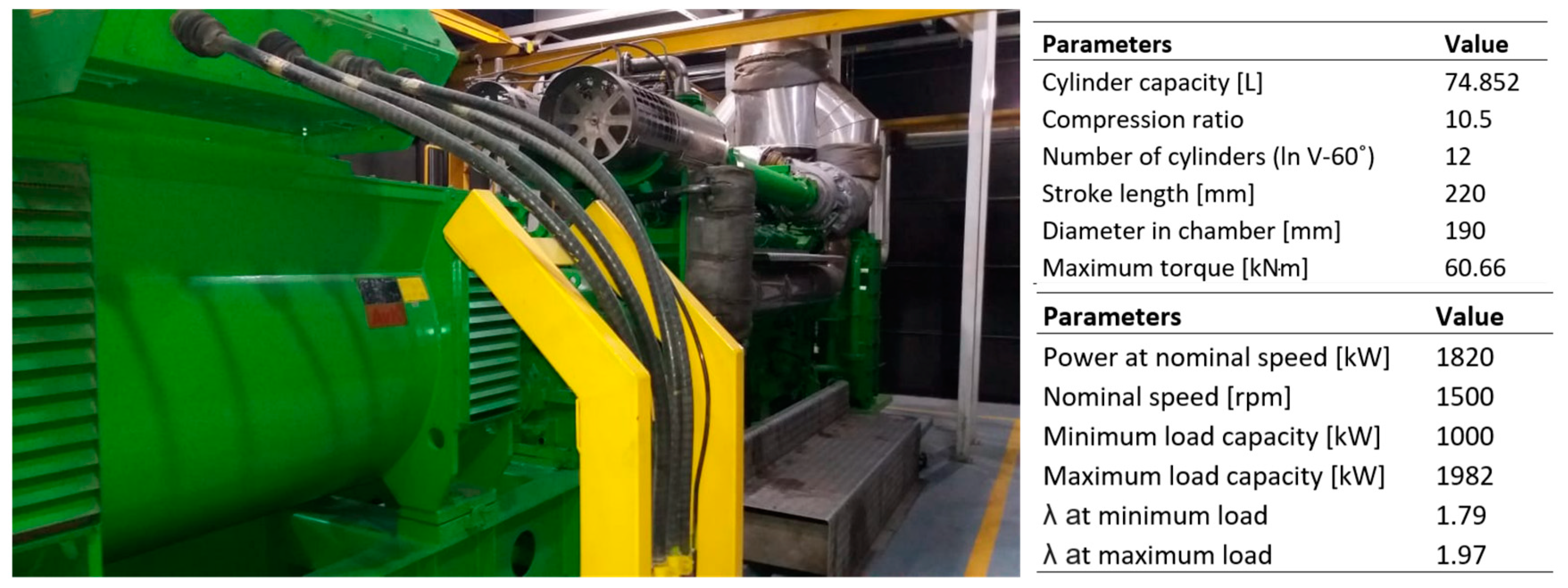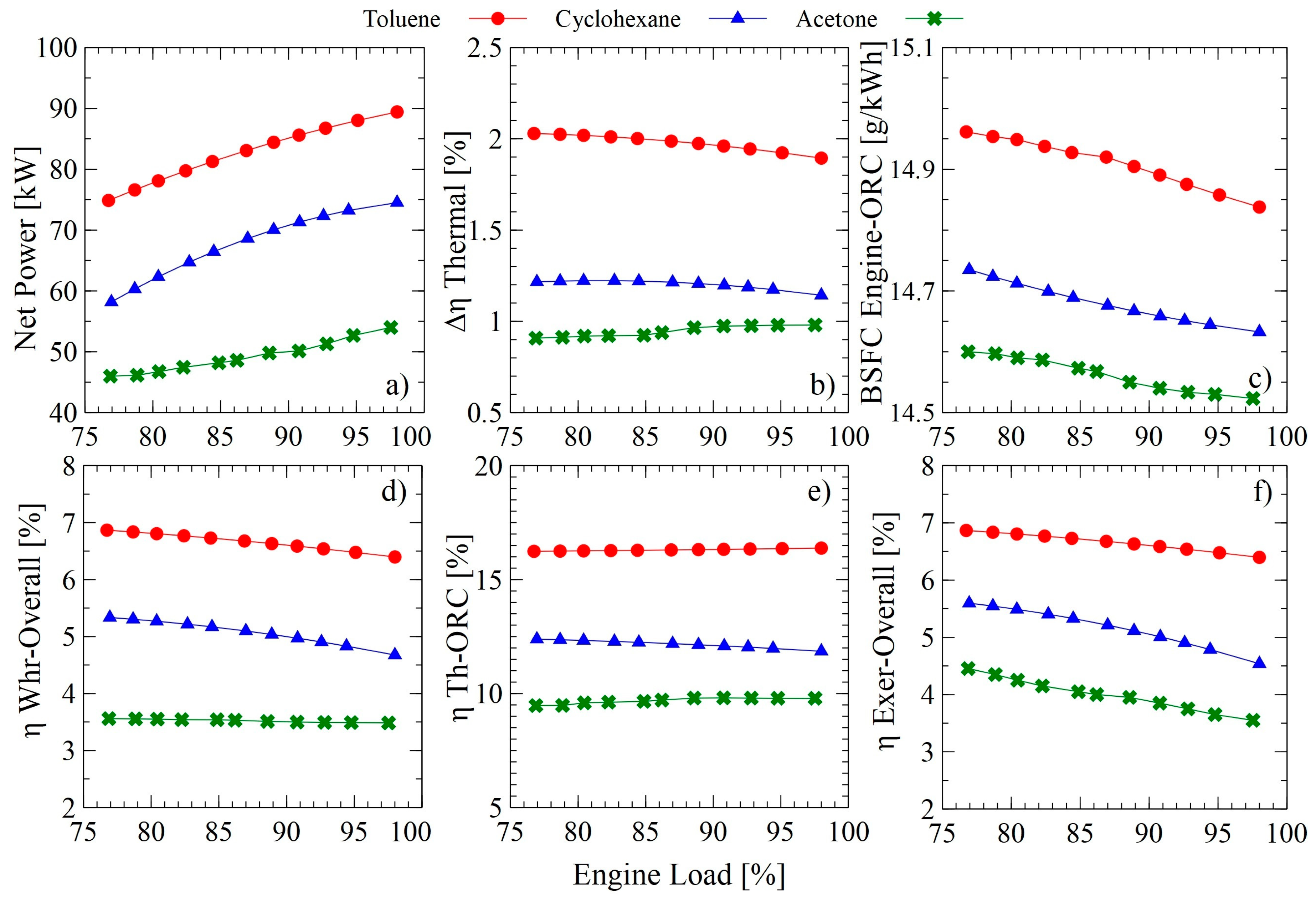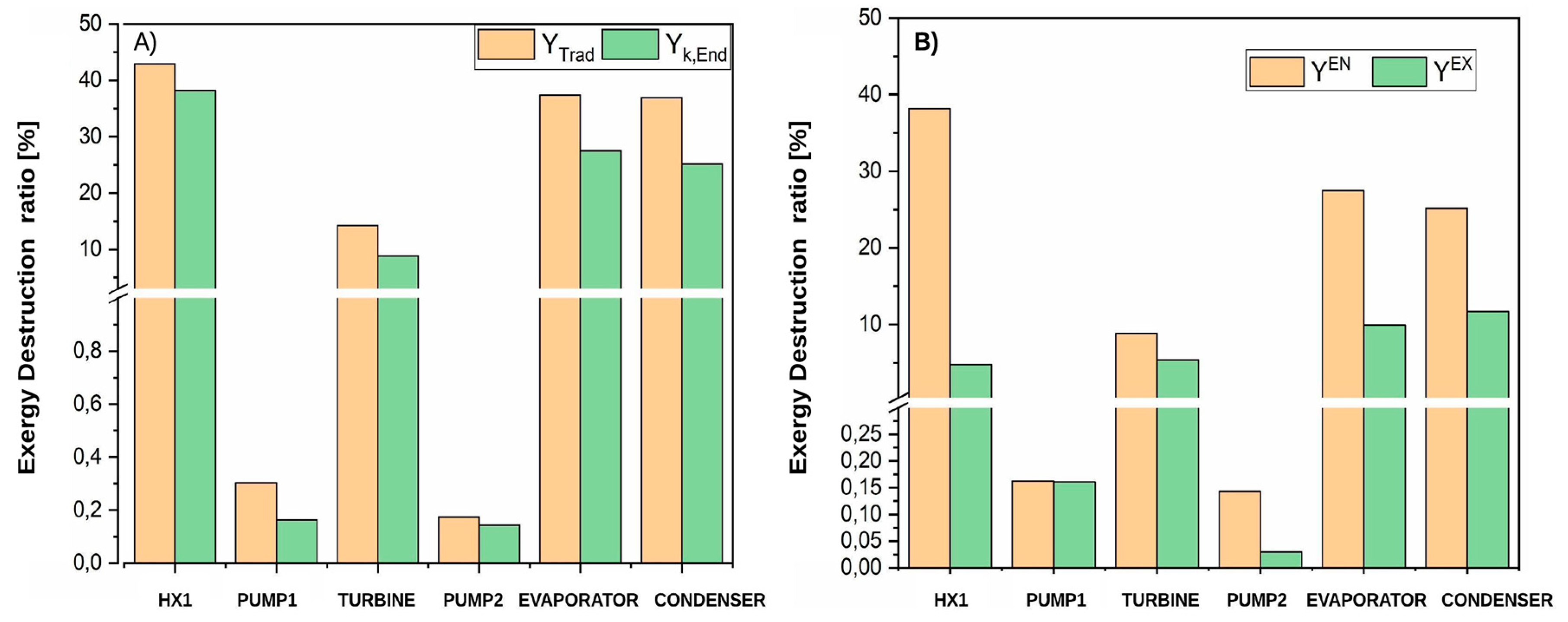Advance Exergo-Economic Analysis of a Waste Heat Recovery System Using ORC for a Bottoming Natural Gas Engine
Abstract
1. Introduction
2. Methodology
2.1. Description of the Cycle
2.2. Energy and Exergy Analyses
- The thermal process and component subsystems were assumed as a steady state condition.
- All thermal devices were assumed in adiabatic conditions.
- The pressure drops in the waste heat recovery based on ORC devices and pipelines were neglected.
- The reference temperature for the physical and chemical exergy calculations was 288 K.
2.3. Advanced Exergetic Analysis
2.4. Conventional Exergo-Economic Analysis
2.5. Advanced Exergo-Economic Análisis
2.5.1. Unavoidable and Avoidable Costs
2.5.2. Endogenous and Exogenous Cost Rates
2.5.3. Splitting Cost Rates
3. Results and Discussion
4. Conclusions
Author Contributions
Funding
Acknowledgments
Conflicts of Interest
Abbreviations
| ICE | Internal Combustion Engine |
| HX 1 | Heat Exchanger 1 |
| HX2 | Heat Exchanger 2 |
| ORC | Organic Rankine Cycle |
| PP | Pinch Point |
| WHR | Waste heat recovery |
| CRF | Capital Recovery Factor |
| Equipment Purchase Cost of component C | |
| Nomenclature | |
| E | Exergy |
| h | Enthalpy |
| Fuel mass rate | |
| P | Pressure |
| Q | Heat |
| s | Entropy |
| Rp | Pressure ratio |
| T | Temperature |
| W | Power |
| Exergy efficiency | |
| η | Energy efficiency |
| Exergy destruction ratio | |
| Investment costs | |
| Endogenous exergy destruction cost rates | |
| Exogenous exergy destruction cost rates | |
| N | Number of annual operation hours |
| Subscripts | |
| 0 | References condition |
| Cond | Condenser |
| ch | Chemical |
| D | Destruction |
| Evap | Evaporator |
| F | Fuel |
| iso | Isoentropic |
| k | Component |
| min | Minimum |
| P | Product |
| ph | Physical |
| Pump | Pump |
| Th | Theorical |
| Tot | Total |
| Turb | Turbine |
| Superscripts | |
| AV | Avoidable |
| EN | Endogenous |
| EX | Exogenous |
| EN, AV | Endogenous avoidable |
| EN, UN | Endogenous unavoidable |
| EX, AV | Exogenous avoidable |
| EX, UN | Exogenous unavoidable |
| id | Ideal |
| RS | Real |
| UN | Unavoidable |
References
- Petrakopoulou, F.; Tsatsaronis, G.; Morosuk, T.; Carassai, A. Conventional and advanced exergetic analyses applied to a combined cycle power plant. Energy 2012, 41, 146–152. [Google Scholar] [CrossRef]
- Morosuk, T.; Tsatsaronis, G. Advanced exergy-based methods used to understand and improve energy-conversion systems. Energy 2019, 169, 238–246. [Google Scholar] [CrossRef]
- Anvari, S.; Khoshbakhti Saray, R.; Bahlouli, K. Conventional and advanced exergetic and exergoeconomic analyses applied to a tri-generation cycle for heat, cold and power production. Energy 2015, 91, 925–939. [Google Scholar] [CrossRef]
- Tsatsaronis, G. Strengths and Limitations of Exergy Analysis BT-Thermodynamic Optimization of Complex Energy Systems; Bejan, A., Mamut, E., Eds.; Springer: Dordrecht, The Netherlands, 1999; pp. 93–100. ISBN 978-94-011-4685-2. [Google Scholar]
- Tsatsaronis, G.; Park, M.-H. On avoidable and unavoidable exergy destructions and investment costs in thermal systems. Energy Convers. Manag. 2002, 43, 1259–1270. [Google Scholar] [CrossRef]
- Kelly, S. Energy Systems Improvement based on Endogenous and Exogenous Exergy Destruction. Ph.D. Thesis, Technische Universität Berlin, Berlin, Germany, 2008. [Google Scholar]
- Petrakopoulou, F. Comparative Evaluation of Power Plants with CO2 Capture: Thermodynamic, Economic and Environmental Performance. Ph.D. Thesis, Technische Universität Berlin, Berlin, Germany, 2010. [Google Scholar]
- Long, R.; Bao, Y.J.; Huang, X.M.; Liu, W. Exergy analysis and working fluid selection of organic Rankine cycle for low grade waste heat recovery. Energy 2014, 73, 475–483. [Google Scholar] [CrossRef]
- Long, R.; Kuang, Z.; Li, B.; Liu, Z.; Liu, W. Exergy analysis and performance optimization of Kalina cycle system 11 (KCS-11) for low grade waste heat recovery. Energy Procedia 2019, 158, 1354–1359. [Google Scholar] [CrossRef]
- Tian, H.; Shu, G.; Wei, H.; Liang, X.; Liu, L. Fluids and parameters optimization for the organic Rankine cycles (ORCs) used in exhaust heat recovery of Internal Combustion Engine (ICE). Energy 2012, 47, 125–136. [Google Scholar] [CrossRef]
- Zare, V. A comparative exergoeconomic analysis of different ORC configurations for binary geothermal power plants. Energy Convers. Manag. 2015, 105, 127–138. [Google Scholar] [CrossRef]
- Kerme, E.D.; Orfi, J. Exergy-based thermodynamic analysis of solar driven organic Rankine cycle. J. Therm. Eng. 2015, 1, 192–202. [Google Scholar] [CrossRef]
- Boyano, A.; Morosuk, T.; Blanco-Marigorta, A.M.; Tsatsaronis, G. Conventional and advanced exergoenvironmental analysis of a steam methane reforming reactor for hydrogen production. J. Clean. Prod. 2012, 20, 152–160. [Google Scholar] [CrossRef]
- Morozyuk, T.; Tsatsaronis, G. Strengths and Limitations of Advanced Exergetic Analyses. In Proceedings of the ASME International Mechanical Engineering Congress and Exposition, San Diego, CA, USA, 15–21 November 2013; Volume 6. [Google Scholar]
- Mortazavi, A.; Ameri, M. Conventional and advanced exergy analysis of solar flat plate air collectors. Energy 2018, 142, 277–288. [Google Scholar] [CrossRef]
- Mohammadi, Z.; Fallah, M.; Mahmoudi, S.M.S. Advanced exergy analysis of recompression supercritical CO2 cycle. Energy 2019, 178, 631–643. [Google Scholar] [CrossRef]
- Yue, T.; Lior, N. Exergo-economic competitiveness criteria for hybrid power cycles using multiple heat sources of different temperatures. Energy 2017, 135, 943–961. [Google Scholar] [CrossRef]
- Marami Milani, S.; Khoshbakhti Saray, R.; Najafi, M. Exergo-economic analysis of different power-cycle configurations driven by heat recovery of a gas engine. Energy Convers. Manag. 2019, 186, 103–119. [Google Scholar] [CrossRef]
- Petrakopoulou, F.; Tsatsaronis, G.; Morosuk, T. Advanced Exergoeconomic Analysis of a Power Plant with CO2 Capture. Energy Procedia 2015, 75, 2253–2260. [Google Scholar] [CrossRef]
- Ambriz-Díaz, V.M.; Rubio-Maya, C.; Ruiz-Casanova, E.; Martínez-Patiño, J.; Pastor-Martínez, E. Advanced exergy and exergoeconomic analysis for a polygeneration plant operating in geothermal cascade. Energy Convers. Manag. 2019, 112227. [Google Scholar] [CrossRef]
- Nazari, N.; Heidarnejad, P.; Porkhial, S. Multi-objective optimization of a combined steam-organic Rankine cycle based on exergy and exergo-economic analysis for waste heat recovery application. Energy Convers. Manag. 2016, 127, 366–379. [Google Scholar] [CrossRef]
- Mikielewicz, D.; Wajs, J.; Ziółkowski, P.; Mikielewicz, J. Utilisation of waste heat from the power plant by use of the ORC aided with bleed steam and extra source of heat. Energy 2016, 97, 11–19. [Google Scholar] [CrossRef]
- Scaccabarozzi, R.; Tavano, M.; Invernizzi, C.M.; Martelli, E. Thermodynamic Optimization of heat recovery ORCs for heavy duty Internal Combustion Engine: Pure fluids vs. zeotropic mixtures. Energy Procedia 2017, 129, 168–175. [Google Scholar] [CrossRef]
- Zhang, H.; Guan, X.; Ding, Y.; Liu, C. Emergy analysis of Organic Rankine Cycle (ORC) for waste heat power generation. J. Clean. Prod. 2018, 183, 1207–1215. [Google Scholar] [CrossRef]
- Galindo, J.; Ruiz, S.; Dolz, V.; Royo-Pascual, L. Advanced exergy analysis for a bottoming organic rankine cycle coupled to an internal combustion engine. Energy Convers. Manag. 2016, 126, 217–227. [Google Scholar] [CrossRef]
- Dai, B.; Zhu, K.; Wang, Y.; Sun, Z.; Liu, Z. Evaluation of organic Rankine cycle by using hydrocarbons as working fluids: Advanced exergy and advanced exergoeconomic analyses. Energy Convers. Manag. 2019, 197, 111876. [Google Scholar] [CrossRef]
- Valencia, G.; Acevedo, C.; Duarte, J. Thermoeconomic optimization with PSO algotithm of waste heat recovery system based on Organic Rankine Cycle system for a natural engine. Energies 2019, 12, 4165. [Google Scholar] [CrossRef]
- Ochoa, G.V.; Peñaloza, C.A.; Rojas, J.P. Thermoeconomic modelling and parametric study of a simple orc for the recovery ofwaste heat in a 2 MW gas engine under differentworking fluids. Appl. Sci. 2019, 9, 4526. [Google Scholar] [CrossRef]
- Ochoa, G.V.; Isaza-Roldan, C.; Forero, J.D. A phenomenological base semi-physical thermodynamic model for the cylinder and exhaust manifold of a natural gas 2-megawatt four-stroke internal combustion engine. Heliyon 2019, 5, e02700. [Google Scholar] [CrossRef] [PubMed]
- Regulagadda, P.; Dincer, I.; Naterer, G.F. Exergy analysis of a thermal power plant with measured boiler and turbine losses. Appl. Therm. Eng. 2010, 30, 970–976. [Google Scholar] [CrossRef]
- Ahmadi, G.; Toghraie, D.; Azimian, A.; Akbari, O.A. Evaluation of synchronous execution of full repowering and solar assisting in a 200MW steam power plant, a case study. Appl. Therm. Eng. 2017, 112, 111–123. [Google Scholar] [CrossRef]
- Taner, T.; Sivrioglu, M. Energy–exergy analysis and optimisation of a model sugar factory in Turkey. Energy 2015, 93, 641–654. [Google Scholar] [CrossRef]
- Ahmadi, G.; Toghraie, D.; Akbari, O.A. Solar parallel feed water heating repowering of a steam power plant: A case study in Iran. Renew. Sustain. Energy Rev. 2017, 77, 474–485. [Google Scholar] [CrossRef]
- Valencia, G.; Fontalvo, A.; Cárdenas, Y.; Duarte, J.; Isaza, C. Energy and exergy analysis of different exhaust waste heat recovery systems for natural gas engine based on ORC. Energies 2019, 12, 2378. [Google Scholar] [CrossRef]
- Quoilin, S.; Aumann, R.; Grill, A.; Schuster, A.; Lemort, V.; Spliethoff, H. Dynamic modeling and optimal control strategy of waste heat recovery Organic Rankine Cycles. Appl. Energy 2011, 88, 2183–2190. [Google Scholar] [CrossRef]
- Sayyaadi, H. Multi-objective approach in thermoenvironomic optimization of a benchmark cogeneration system. Appl. Energy 2009, 86, 867–879. [Google Scholar] [CrossRef]
- Ghaebi, H.; Amidpour, M.; Karimkashi, S.; Rezayan, O. Energy, exergy and thermoeconomic analysis of a combined cooling, heating and power (CCHP) system with gas turbine prime mover. Int. J. Energy Res. 2011, 35, 697–709. [Google Scholar] [CrossRef]
- Bejan, A.; Tsatsaronis, G.; Moran, M.J. Thermal Design & Optimization; John Wiley & Sons: Hoboken, NJ, USA, 1995; ISBN 0-471-58467-3. [Google Scholar]
- Valencia, G.; Núñez, J.; Duarte, J. Multiobjective optimization of a plate heat exchanger in a waste heat recovery organic rankine cycle system for natural gas engines. Entropy 2019, 21, 655. [Google Scholar] [CrossRef]
- Valencia, G.; Duarte, J.; Isaza-Roldan, C. Thermoeconomic analysis of different exhaust waste-heat recovery systems for natural gas engine based on ORC. Appl. Sci. 2019, 9, 4017. [Google Scholar] [CrossRef]
- Morosuk, T.; Tsatsaronis, G. Advanced Exergoeconomic Analysis of a Refrigeration Machine: Part 1—Methodology and First Evaluation. In Proceedings of the ASME 2011 International Mechanical Engineering Congress and Exposition, Denver, CO, USA, 11–17 November 2011; pp. 47–56. [Google Scholar]
- Morosuk, T.; Tsatsaronis, G. Advanced Exergoeconomic Analysis of a Refrigeration Machine: Part 2—Improvement. In Proceedings of the ASME 2011 International Mechanical Engineering Congress and Exposition, Denver, CO, USA, 11–17 November 2011; pp. 57–65. [Google Scholar]
- Budes, F.B.; Ochoa, G.V.; Escorcia, Y.C. Hybrid PV and Wind grid-connected renewable energy system to reduce the gas emission and operation cost. Contemp. Eng. Sci. 2017, 10, 1269–1278. [Google Scholar] [CrossRef][Green Version]
- Diaz, G.A.; Forero, J.D.; Garcia, J.; Rincon, A.; Fontalvo, A.; Bula, A.; Padilla, R.V. Maximum power from fluid flow by applying the first and second laws of thermodynamics. J. Energy Resour. Technol. 2017, 139, 032903. [Google Scholar] [CrossRef]






| Component | Real Conditions | Theorical Conditions | Unavoidable Exergy Destruction | Unavoidable Investment Costs |
|---|---|---|---|---|
| Pump 1 | ||||
| Turbine | ||||
| Condenser | ||||
| Evaporator | ||||
| Pump 2 |
| Components | Ef [kW] | Ep [kW] | Ed [kW] | Eloss [kW] | E [%] | Yd,k | Cf [USD/GJ] | Cp [USD/GJ] | Cd [USD/h] | Closs [USD/h] | Z [USD/h] | Z + Cd + Closs [USD/h] | fc [%] |
|---|---|---|---|---|---|---|---|---|---|---|---|---|---|
| HX 1 | 541.20 | 202.79 | 41.95 | 338.40 | 37.47 | 32.54 | 15.22 | 11.97 | 2.30 | 16.24 | 2.67 | 21.22 | 53.79 |
| P1 | 0.37 | 0.05 | 0.31 | - | 15.60 | 0.24 | 47.56 | 1801.58 | 0.05 | - | 0.29 | 0.34 | 85.24 |
| Turb | 99.48 | 85.58 | 13.89 | - | 86.03 | 10.77 | 19.11 | 47.85 | 0.95 | - | 7.89 | 8.85 | 89.20 |
| P2 | 0.75 | 0.58 | 0.16 | - | 77.60 | 0.13 | 47.85 | 197.65 | 0.02 | - | 0.28 | 0.31 | 90.78 |
| Evap | 202.85 | 166.34 | 36.51 | - | 82.00 | 28.32 | 12.46 | 18.48 | 1.63 | - | 1.96 | 2.60 | 54.58 |
| Cond | - | - | 36.05 | 66.58 | - | 27.97 | 55.48 | 19.11 | 7.18 | 13.27 | 1.61 | 22.07 | 18.35 |
| Components | ||||||||
|---|---|---|---|---|---|---|---|---|
| HX 1 | 37.339 | 4.615 | 4.000 | 37.953 | 0.000 | 0.000 | 0.000 | 0.000 |
| Pump 1 | 0.159 | 0.157 | 0.011 | 0.030 | 0.015 | 0.290 | 0.144 | −0.133 |
| Turbine | 8.661 | 5.229 | 11.075 | 2.819 | 0.095 | 1.869 | 7.711 | 3.360 |
| Pump 2 | 0.140 | 0.029 | 0.140 | 0.028 | 0.011 | 0.016 | 0.013 | 0.012 |
| Evaporator | 26.849 | 9.663 | 3.542 | 32.971 | 0.000 | 0.000 | 0.000 | 0.000 |
| Condenser | 24.607 | 11.451 | 0.000 | 0.000 | 0.000 | 0.000 | 0.000 | 0.000 |
| Total | 97.755 | 31.144 | 18.768 | 73.801 | 0.121 | 2.175 | 7.868 | 3.239 |
| % | 75.83% | 24.16% | - | - | 0.14% | 6.69% | 8.14% | 10.79% |
| Components | CD,k [USD/h] | CD,kEN [USD/h] | CD,kEX [USD/h] | CD,kAV [USD/h] | CD,kUN [USD/h] | CD,kAV,EN [USD/h] | CD,kAV,EX [USD/h] | CD,kUN,EN [USD/h] | CD,kUN,EX [USD/h] |
|---|---|---|---|---|---|---|---|---|---|
| HX 1 | 2.300 | 2.047 | 0.253 | 0.219 | 2.080 | 0.000 | 0.000 | 0.000 | 0.000 |
| Pump 1 | 0.051 | 0.027 | 0.027 | 0.005 | 0.049 | 0.025 | −0.019 | 0.002 | 0.047 |
| Turbine | 0.956 | 0.591 | 0.3599 | 0.701 | 0.254 | 0.531 | 0.171 | 0.065 | 0.188 |
| Pump 2 | 0.029 | 0.024 | 0.005 | 0.024 | 0.005 | 0.022 | 0.002 | 0.002 | 0.003 |
| Evaporator | 1.638 | 1.205 | 0.433 | 0.159 | 1.479 | 0.000 | 0.000 | 0.000 | 0.000 |
| Condenser | 7.188 | 4.906 | 2.283 | 0.000 | 0.000 | 0.000 | 0.000 | 0.000 | 0.000 |
| Components | Zd,k [USD/h] | ZEN [USD/h] | ZEX [USD/h] | ZAV [USD/h] | ZUN [USD/h] | ZAV,EN [USD/h] | ZAV,EX [USD/h] | ZUN,EN [USD/h] | ZUN,EX [USD/h] |
|---|---|---|---|---|---|---|---|---|---|
| HX 1 | 2.678 | 2.648 | 0.030 | −0.046 | 2.724 | 0.251 | −0.297 | 2.397 | 0.328 |
| Pump 1 | 0.295 | 0.288 | 0.007 | 0.001 | 0.294 | −0.170 | 0.171 | 0.458 | −0.164 |
| Turbine | 7.898 | 5.417 | 2.480 | 2.215 | 5.683 | 0.053 | 2.161 | 5.364 | 0.319 |
| Evaporator | 1.970 | 1.957 | 0.013 | 0.022 | 1.948 | 0.025 | −0.004 | 1.932 | 0.016 |
| Condenser | 1.760 | 1.645 | 0.115 | 0.100 | 1.660 | - | - | - | - |
© 2020 by the authors. Licensee MDPI, Basel, Switzerland. This article is an open access article distributed under the terms and conditions of the Creative Commons Attribution (CC BY) license (http://creativecommons.org/licenses/by/4.0/).
Share and Cite
Valencia Ochoa, G.; Piero Rojas, J.; Duarte Forero, J. Advance Exergo-Economic Analysis of a Waste Heat Recovery System Using ORC for a Bottoming Natural Gas Engine. Energies 2020, 13, 267. https://doi.org/10.3390/en13010267
Valencia Ochoa G, Piero Rojas J, Duarte Forero J. Advance Exergo-Economic Analysis of a Waste Heat Recovery System Using ORC for a Bottoming Natural Gas Engine. Energies. 2020; 13(1):267. https://doi.org/10.3390/en13010267
Chicago/Turabian StyleValencia Ochoa, Guillermo, Jhan Piero Rojas, and Jorge Duarte Forero. 2020. "Advance Exergo-Economic Analysis of a Waste Heat Recovery System Using ORC for a Bottoming Natural Gas Engine" Energies 13, no. 1: 267. https://doi.org/10.3390/en13010267
APA StyleValencia Ochoa, G., Piero Rojas, J., & Duarte Forero, J. (2020). Advance Exergo-Economic Analysis of a Waste Heat Recovery System Using ORC for a Bottoming Natural Gas Engine. Energies, 13(1), 267. https://doi.org/10.3390/en13010267








